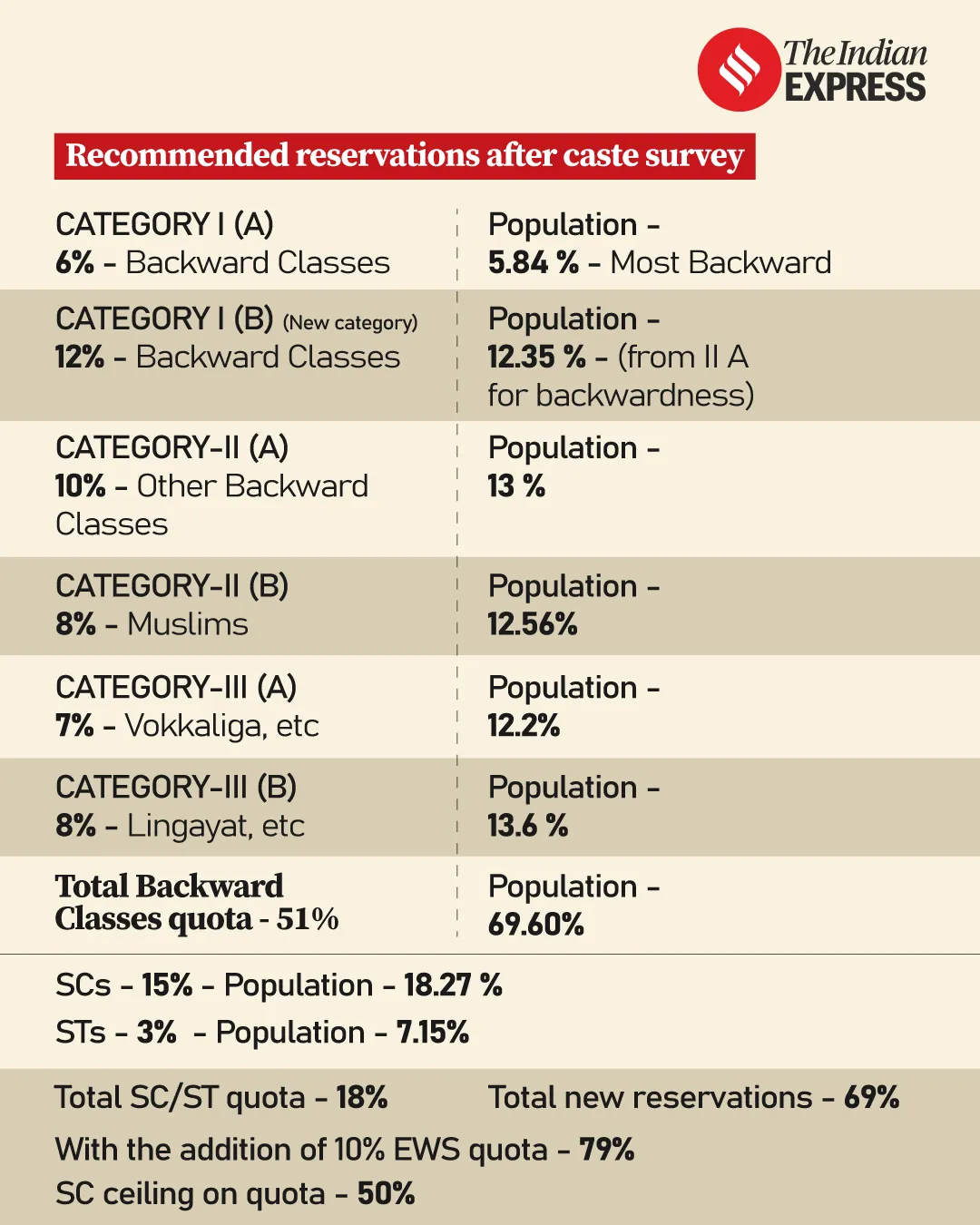Karnataka Caste Survey Report | 16 Apr 2025
Why in News?
The Karnataka government tabled the caste survey report, officially known as the Socio-Economic and Education Survey, conducted by the State Backward Classes Commission.
- The survey recommends a significant revamp of the reservation quota structure and the introduction of new subcategories.
What are the Key Findings of the Karnataka Caste Survey?
- Key Findings: Other Backward Classes (OBCs) population estimated at 69.6% of the state's population, nearly 38% higher than earlier assumptions.
- Dominant communities like Vokkaligas (at 12.2%) and Lingayats (at 13.6%) were found to be numerically weaker than earlier estimates of 17% and 15% respectively.
- Recommendations: The survey recommends raising the OBC quota from current 32% to 51%, a significant increase that challenges the Supreme Court's 50% reservation cap set in the Indra Sawhney (1992) judgment.
- A new sub-category, I B is suggested to be created for the Most Backward Classes, carved from the II A category.
Note: In Indra Sawhney v. Union of India (1992), the Supreme Court set a 50% cap on reservations in government jobs and education to balance affirmative action with merit. It also introduced the 'creamy layer' concept, excluding affluent OBCs from reservations.
What is a Caste Survey?
- About: A Caste Survey is a method of collecting data from a sample of the population, focusing on caste-based social, economic, and educational conditions. It only surveys a subset of the population.
- It is usually conducted by state governments to create a comprehensive caste-wise database for policy decisions.
- Need: The broad categories of SC, ST, and OBC encompass diverse castes, often masking internal disparities. Without detailed caste data, dominant sub-groups tend to corner benefits, while truly disadvantaged groups remain underserved.
- This hampers targeted policymaking, making a caste survey essential for equitable representation and effective welfare delivery.
- Implications: Enables evidence-based policymaking and targeted welfare schemes. Supports demands for revisiting the 50% reservation ceiling based on demographic and socio-economic realities.
- Helps curb misuse of reservation benefits by affluent sections of backward classes by highlighting intra-group disparities.
Caste Census
- Caste Census is an exhaustive enumeration of the entire population, collecting detailed data on caste, socio-economic conditions, and other demographic factors, covering every individual in the country.
- The Caste Census is under the administrative control of the Ministry of Home Affairs, specifically the Registrar General of India (RGI) and the Census Commissioner of India.
- The Ministry of Rural Development launched the Socio-Economic Caste Census (SECC) in 2011, conducting a nationwide door-to-door survey to gather data on socio-economic status and caste composition.
- The SECC aimed to identify marginalized groups and improve welfare targeting. However, a significant portion of its data remains unreleased or only partially available, limiting its utility in policymaking and public discourse.
|
Drishti Mains Question: Examine the significance of the caste survey in addressing intra caste disparities and its implications on the reservation policy in India. |
UPSC Civil Services Examination, Previous Year Question
Mains
Q. Do government’s schemes for up-lifting vulnerable and backward communities by protecting required social resources for them, lead to their exclusion in establishing businesses in urban economies? (2014)
Q. Discuss the role of the National Commission for Backward Classes in the wake of its transformation from a statutory body to a constitutional body. (2022)

